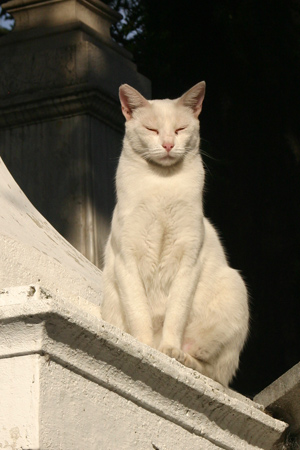
Documenting Recoleta Cemetery in Buenos Aires since 2007
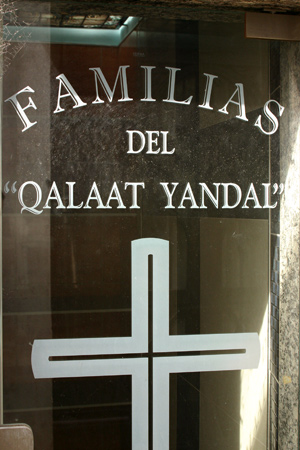
This new addition doesn’t seem to fit within the general artistic quality found in the rest of the cemetery. Glass doors are common in modern mausoleums but are typically etched with symbols already mentioned in this blog or simply left without decoration. Although the door is very different, it’s not horrible… but the garden statue placed on top really needs to go:
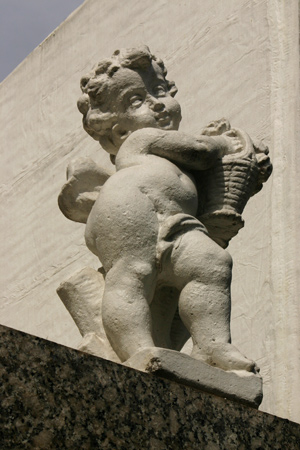
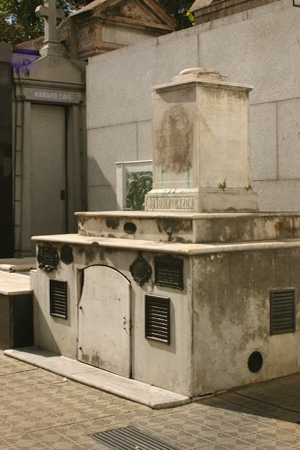
Unassuming & rather neglected, one of the founding fathers of Argentina lies inside. Nicolás Rodríguez Peña was born in 1775 in Buenos Aires & after a short stint in the military, he decided to go into the soap business with Hipólito Vieytes. Vieytes & Rodríguez Peña turned out to share more just than commercial interests… they were responsible for gathering support to declare independence from Spain in 1810. Discreet meetings took place either in the soap factory or at the country estate of Rodríguez Peña.
The early years after independence were rocky ones. In 1812, Rodríguez Peña formed part of a brief triumvirate government along with Juan José Paso & Antonio Álvarez Jonte. But factions came & went, & so did Rodríguez Peña’s influence in Buenos Aires. Eventually caught on the wrong side, he chose to join San Martín in ousting the Spanish from Chile & remained there after the decisive battle in Chacabuco. Spending 37 years away from Argentina, Rodríguez Peña died in Santiago de Chile in 1853.
His remains were brought back to Buenos Aires in 1894 & placed in Recoleta Cemetery in a family vault built after his departure from Argentina. On the base of the pedestal, a list of family members related to Nicolás includes his wife, Casilda Ygarzábal de Rodríguez Peña, who passed away in 1844 & Joaquín who died in 1869:
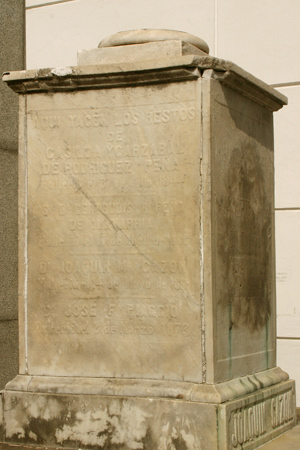
Small plaques below the pedestal are the only reminder that Nicolás is buried here:
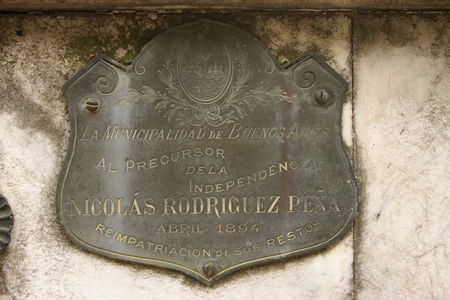
The participation of Rodríguez Peña in the independence of South America is noteworthy not only because of his constant participation regardless of internal conflicts, but also because he used his entire fortune to support the cause. Now that’s dedication. This tomb was declared a National Historic Monument in 1946 & is scheduled for restoration later this year. Unfortunately nothing remains of the estate in Buenos Aires where revolutionary meetings were held, but that location is now a beautiful public square filled with jacarandá trees which bears his name… Plaza Rodríguez Peña:
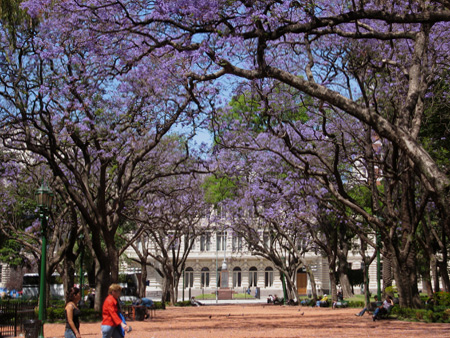
Update (Jun 2008): About one year after this post was written, the crypt was restored & the column replaced. Text on the column is in French—some unreadable & with mistakes—but the general idea is easily conveyed:
N. R. Peña / jeune americain / de Buenos Ayres / mort malhuereusement / le 13 janvier 1831. / Sa mort / à laissé ses amis [column broken] / inconsolables / à prive ses parens / du meilleur des fils / et son pays / d’un citoyen habile / et vertueux / quien aurait été / sans doute lux des plus / beaux obnemens [difficult to decipher]
N.R. Peña, young American from Buenos Aires, sadly died the 13th of January 1831. His death has left his friends unconsolable, has deprived his parents of their best son & his country of an able & virtuous citizen who would have been without doubt the most beautiful light…
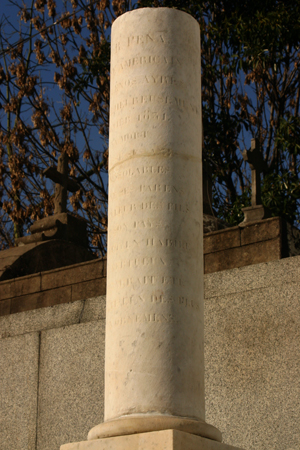
Receiving 2,000 visitors each day, Recoleta Cemetery renews its historical brilliance; more than 100 monuments have already been restored & works continue this year.
Byline: Susana Reinoso
María Rosa Lojo writes about Recoleta Cemetery: “In this museum of mortals, the personal ramblings of its inhabitants —famous or obscure— blend inextricably with Argentine history.” In her work Hidden Stories of Recoleta which was just republished by Alfaguara, the novelist exquisitely states that whoever walks with their ears alert can hear in the cemetery, one of the most popular places in Buenos Aires for tourists, “the murmor of remarkable lives against the immense chorus of collective memory.”
Precisely because this mortuary museum brings together much of the best funerary architecture & statuary in Buenos Aires, the city government will continue the Recoleta Cemetery Revaluation Program, which aims to conserve & restore the sculptures, vaults, sepulcres & tombs. Approval [for continued funding] came at the end of 2007.
With the intervention of the Subsecretary of City Heritage, the Friends’ Association of Recoleta Cemetery —headed by Marta Salas— and the General Administration of Cemeteries —whose director is Néstor Pan— they have completed since 2002 a remarkable plan of recovering that architecture.
Art & Remembrance
Each day the cemetery receives an average of 2,000 visitors. That equates to more than 700,000 people per year since the cemetery is open Monday through Sunday.
“Over 100 monuments have already been recovered, & we rely on group of highly qualified restorers who work with love & a sense of patriotism,” says Marta Salas to La Nación newspaper.
The President of the Friends’ Association points out: “This effort comes from the fact that we consider Recoleta Cemetery to be the most relevant historical/artistic space in our country, & we are proud to show it to the thousands of tourists who visit it.” The organization, which sells detailed maps of the cemetery to tourists, uses part of the proceeds for restoration of historical monuments.
A brief walk through, like the one taken by La Nación reporters, confirms this. The crowds never stop coming, & there are not enough guides to answer every question. Visitors always make a pilgrimage to the sepulcre of Eva Duarte de Perón.
The director of the cemetery, Carlos Francavilla, states that the revaluation of the cemetery is not [immediately] visible to most people. However the scaffolding & work materials around certain monuments make people realize that restoration is in progress.
This year the program has planned to restore the sculptures & vaults of Adolfo Alsina, Nicolás Rodríguez Peña, Juan José Viamonte, Rufina Cambaceres & Pedro J. Díaz.
In each instance, the work of restoration & maintenance carries out the elimination of invasive vegetation, replacement of missing material, elimination of the deteriorated outer layer, chemical cleaning & an anti-corrosive treatment.
In 2006, restoration was performed on the sepulcres & mausoleums of Bartolomé Mitre, Domingo Fidel Sarmiento, Carlos Pellegrini & Juan Martín de Pueyrredón. Last year, works focused on the mausoleums of Luis María Campos & Nicolás Avellaneda, the vault of the José C. Paz family, the Pantheon for Meritorious Citizens & the sculpture of Christ in the cemetery chapel.
———————————
Original article in Spanish located here.
Leave a Comment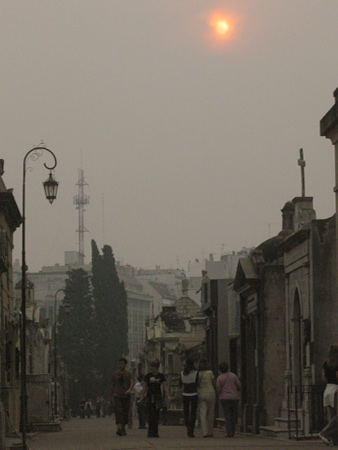
Thanks to two weeks of brush fires north of Buenos Aires, the city is now covered with a thick layer of smoke. The cemetery makes a perfect foreground for yesterday’s apocalyptic sun.
Leave a Comment